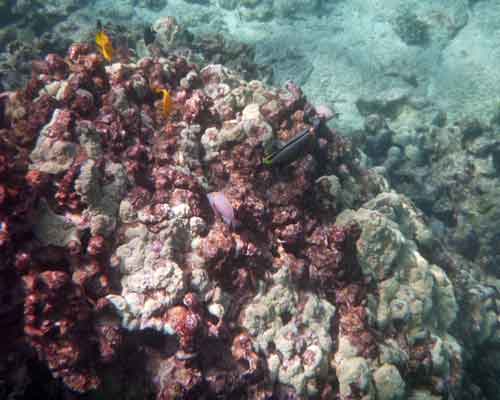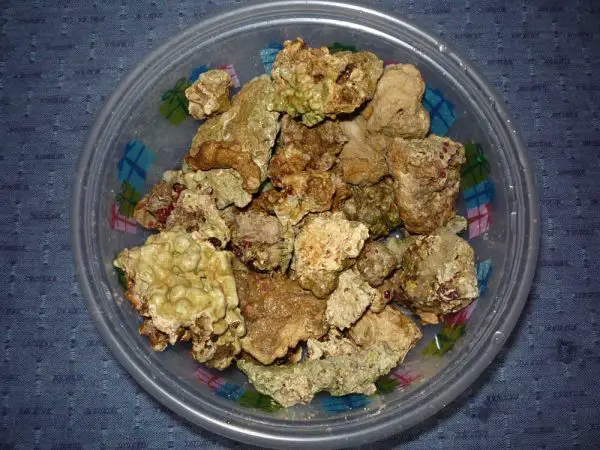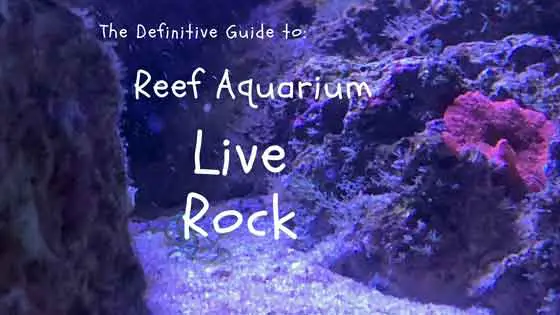What is live rock?
What is live rock? Where should I start? The term itself is a bit awkward, which leads to some of the confusion. Technically speaking, live rock is not alive.
Equally technically speaking, it very much is a rock.

The living part of the rock is not the rock itself, but rather the tiny invertebrates, algae, and bacteria that live in and on it.
These bacteria, algae, and invertebrates colonize the rock naturally. While traditional live rock tends to be calcareous and porous, just about any rock that has been in a reef tank or the ocean for more than a few weeks could also technically consider itself (if it was alive) to be a live rock.
Oh, by the way, calcareous is just a fancy word for calcium carbonate based—the same stuff that coral reefs are made from. Porous just means it’s lightweight and full of pores/holes.
Being porous is an important feature in live rock because it makes these rocks lighter than other less porous rocks—and since they are generally shipped great distances, and is also sold by the pound, this cuts down on shipping and acquisition costs.
Porosity also has the added benefit of creating additional surface area (nooks and crannies), which means more places for that marine life to grow.
Benefits
Live rock serves three main purposes in the average reef tank:

Structure
Liverock provides the main structure for the reef tank in your home or office—it is:
- the backbone you attach corals to
- a place for your fish and mobile invertebrates to hide in, crawl on and swim through
- a visually interesting object that creates visual appeal and dimension in your tank
Biological Filtration
While I’ve never actually counted the bacteria growing on my rock, it seems reasonable to estimate that millions of beneficial bacteria hang out in and on the rocks in my tank, just waiting to help clean up the water.
If you ever count yours, please be sure to leave a comment below and let us know how many bacteria you found on your rock.
One type of bacteria turns toxic ammonia waste (produced by your fishes, corals and excess food) into nitrite. Another turns that nitrite into nitrate. The colonization of these beneficial bacteria and the establishment of a healthy biological filter is one of the most important steps in reef keeping.
Biodiversity
Live rock is like a box of chocolates—crawling with worms, bacteria, algae and other invertebrates. Okay, that’s gross. I was actually going for the Forrest Gump line there, you never know what you’re going to get.
If you don’t know what Forrest Gump is, sigh…I’m getting old.
Perhaps the coolest benefit is all the stuff growing on it that makes it live rock. These critters add to the biodiversity of your tank. They are tiny gifts you will discover over and over again, which adds an interesting dimension to your tank and gives you something new to discover and watch.
Tiny hitchhikers, living in and on the rock take a ride across the Pacific Ocean and make their way into your tank and bring starfish, snails, bristle worms, copepods, amphipods and other cool little critters into your tank.
Many of them are also beneficial, cleaning up extra food particles, or eating detritus, etc., Almost all of them are interesting if you take the time to find and observe them.
Drawbacks
Cost can be expensive
Live rock is expensive. You could end up spending hundreds of dollars…on rocks! Your non-aquarium-loving family members might think your head is full of rocks when they find out how much money you spent on them.
Bad hitchhikers
While beneficial liverock hitchhikers are one of the coolest benefits, dangerous or deadly hitchhikers are one of the biggest potential drawbacks. These aren’t common, but the horror stories certainly do have a habit of sticking around the forums, for good reason. Mantis shrimp, aiptasia anemones, problem algae, hydra, and even saltwater ich cysts can find their way into your tank via a live rock bus and wreak some havoc.
Because of these potential drawbacks, many aquarium owners prefer to use dry rock as the base rock for most of their reef structure and supplement it with just a small amount of (artificial, aquaculture or traditional) rock.
Learn more about live rock hitchhikers here.
What is live rock rubble?
When I read the word “rubble”, I think of the pile of tiny rocks left behind after one of those cool building demolition videos.
Live rock rubble is the way less cool cousin of that. When small pieces of rock fall apart due to rough handling, shipping, being stepped on by snorkelers, wave action or storms,, those small pieces roll or fall down to the bottom.
If you create a small pile of rubble in your tank or sump, it will make a great home for some of the larger tiny invertebrates, like copepods.
Rubble also makes a great and very natural looking substrate to attach coral frags to.

What is cured live rock?
When the live rock is pulled out of the ocean or aquaculture vessel, it is generally packed into a large styrofoam cooler and covered with wet newspapers, or some other way of keeping it moist.
But due to the added weight and shipping cost, it is generally not submerged in water.
The result is that some of those beneficial critters you were hoping would hitchhike their way into your tank on the live rock die because of the shipping stress.
When they die, they rot. When they rot, they release toxic chemicals, like ammonia.
After a few weeks, the stuff that’s going to die has already died and the stuff that is going to live will likely be okay.
Once the rock has stabilized and reached that stage, it is considered cured.
How to cure live rock
Curing live rock is critically important, but not technically difficult. The basic idea is that you try to provide the rock with a happy reef home:
Give it warm, clean, oxygenated, circulating water
In return for giving you a happy home, the live rock will cure itself.
When is it cured?
After at least 3 weeks, as long as you can’t see anything dying on it and as long as you can’t detect any ammonia with your test kit.
What equipment do you need?
At a bare minimum, you need a big tub, heater, and something to circulate the water—either an air pump or powerhead.
You also need a siphon/gravel vacuum and a bucket—because you will need to do water changes in order to keep the water quality high—if not, you may burn and kill everything on the rocks with ammonia.
If you have one, running a protein skimmer will help you remove some of the water pollutants, but is not necessary.
Deciding whether or not to run lights over your live rock is a bit of a personal decision. Remember, your goal is to keep the helpful, interesting or beneficial organisms alive. So if you want to keep any photosynthetic critters alive, they are going to need light.

However, problem algae also need light—and since problem algae love nitrogen-rich water (water high in ammonia, nitrites or nitrates), lighting your curing live rock could be a recipe for an algae or cyanobacteria explosion.
A compromise could be to wait to turn on the lights until you notice the decay rate has slowed down—meaning you take a look at your water test results and only turn on the lights once you start to see no more ammonia and that the nitrates aren’t climbing as quickly anymore. Be careful to watch your rock closely over the next few days and monitor for cyanobacteria or problem algae and shut the lights back off if you see unsightly growth.
One extremely important point here is that a tank or tub that is curing live rock is not a suitable environment to keep other marine life alive. Your goal is to keep as much of the cool stuff on the rocks to live, and you want to put reasonable effort into maintaining that water quality, but you shouldn’t have anything else (fish, corals, crabs, clams, etc.) in the same tank as the rock, while it is curing.
Curing live rock in the aquarium to cycle it
If the last section sounds a lot like cycling an aquarium, you’re right. When curing the rock, a source of ammonia dead stuff on the rock decaying gets turned into nitrate by helpful bacteria growing on the rocks and sidewalls of the tub or tank you’re curing the rock in. Some people like to use uncured live rock then to jumpstart their biological filter to cycle the tank several weeks to a few months before introducing their first fish.
If you’re going to do that, be sure to run activated carbon for a week or two before adding your first livestock to help remove other chemicals that might have gotten into your water, from the rocks—toxins can sometimes be released by dying palythoa polyps or sponges.s
What are the different types of live rock?
If you are doing other research about live rock, you might come across a few more terms that describe the different types of live rock. Here is a quick explanation of what you might see:
- Natural
- Artificial
- Aquacultured
- Dry Rock
- Base rock
Natural
For years and years, the natural live rock was the dominant rock in the hobby. Natural live rock is real rock that is harvested from a reef.
How does someone ‘harvest’ rock from a reef?
Unfortunately, you do it by busting up the reef, often with explosives or crowbars and things like that.
Not exactly an eco-friendly or reef-friendly options.
People loved natural live rock so much because it was loaded with all sorts of critters who called the reef their home. Those critters living in and on the rocks get a one-way flight into your aquarium.
Part of the ‘fun’ was bringing your rock home, putting it in the tank and seeing what kind of invertebrates or algae you ‘got’, kind of like the prize in a box of cereal.
Quick tangent—my favorite cereal growing up was Trix—what was yours?
The other advantage was…well…it was really the only rock available.
The advantage of natural rock is natural biodiversity. The disadvantages are the cost and negative impact of removing those rocks from the reefs.
The most common types of natural reef rock, from a few years back came from the reefs of Fiji (including Pukani) and Tonga, but regulations now prevent the exportation of this rock.
The rock from different reefs has different aesthetics (look and feel) and densities. Because of that, you may still see those names used in the descriptions of artificial rock that was created to mimic the natural look of the rock from those regions.
Artificial
Artificial rock is a man-made product that is manufactured by companies specifically for use in the home aquarium. The advantages of stocking your tank with artificial rock are that you can create the same look/feel without damaging any natural reefs and with a much lower risk of transporting nasty hitchhikers.
Depending on the type of rock you buy, artificial rock might be sold as ‘biologically active’ or dry rock.
For all of these reasons, artificial rock is generally preferred and is the product I recommend for almost everyone.
Dry rock
I promise, I’m not trying to be snarky here (that’s a first), but dry rock, very simply, is a rock that is intended to be used as a live rock in an aquarium, but it’s completely dry and has no biologically active, viable saltwater organisms growing on it. Technically speaking, dry rock could be artificial, aquaculture or natural rock. Any of the above, as long as it has been completely dried.
The advantages of dry rock are the lower cost and zero possibility of transferring a dangerous hitchhiker.
The disadvantages are that it isn’t as aesthetically pleasing until it becomes colonized by cool, living stuff, and it adds nothing to the biodiversity of the tank.
Aquacultured
Aquacultured rock a term for rock that is ‘grown’ on a live rock farm. I know that sentence sounds funny, but I’m not sure the English language was designed with that sentence in mind. In live rock aquaculture, rocks that are owned by the aquaculture company/farm are intentionally put in the ocean or holding tank system so that live organisms will colonize the rocks.
Those rocks are then harvested, packaged up and shipped out to fish stores and aquarium owners.
Assuming the rock was harvested from a non-living reef source, the rock can be natural, in origin, but colonized actively, without destruction to reefs.
The advantages and disadvantages of this type of rock depend on whether it is ‘grown’ in the ocean or a quarantined facility.
Base rock
Base rock is generally larger, heavier, less attractive rock (tends to be either dry or wet/live with less coralline algae visible). Why would you want larger, heavier, less attractive rock? Simply because it’s cheaper. You can generally fill your aquarium most economically if you build the less visible parts of your rock aquascape with the cheaper base rock and then use the more attractive artificial or aquaculture rock for the visible pieces because the base rock can cost a third of the price of the more attractive rock. Base rock could be sold dry or wet/live.
What is the best live rock to buy?
In my opinion, the best thing to do is buy a combination of dry, base rock to cost-effectively fill up space and supplement with artificial or natural aquacultured live rock.
Why is some live rock purple?
Reef aquarium owners love their live rock because of the purple (and sometimes red or green) colors. The purple color comes from a specific type of algae called coralline algae, which is a sought-after, beneficial alga.
How much live rock do you need?
This is one of the age-old questions in the saltwater aquarium hobby. Unfortunately, there is no single answer to this question that you will find fulfilling. The old rule of thumb was that you ‘should’ add 1-2 pounds of rock for every gallon (~4 liters) of water volume for your tank. That could be as much as 110 pounds for a 55-gallon tank if you follow that rule.
The truth here is that the amount of rock you add to your tank is largely a factor of costs and aesthetics. Buy enough rock to make the aquascape look the way you want. Spend as much (but not more) than you’re willing to spend.
If you’re on a budget, no problem, just buy more rock as you progress.
Consider starting with 10-20 pounds of the good stuff (unless you have a large tank) and supplement with dry rock to get the size and shape of the structure you want to have in your aquarium.
How to cook live rock?
You don’t cook live rock, ever! Unfortunately, that term has been used for a long time to mean the same thing as curing live rock and that has led to some people getting hurt. The phrase is meant to describe the recommended process of placing the rock in a vessel outside of the main tank, in a secondary vessel filled with salt water, heated and aerated for a month or two. The live rock travels a long way from the reef or aquaculture location to the local fish store and then your home. Because of how heavy it already is, the live rock is shipped damp, but not submerged in water. As a result of this travel and handling, some of the living organisms on the rock die. This dying off can leach toxins and ammonia into the water, so it is generally recommended to cure the rock in advance. “Cooking” the rock is messenger board jargon for the same thing, but please be clear, there is no cooking involved.
There are reports of a hobbyist who literally boiled their rock and got his family very sick, from palytoxin poisoning. So let’s all agree to not use this term, deal?
Other questions
Have any other questions that are not answered here? If so, please leave a comment below and I’ll do my best to answer it.





Leave a Reply